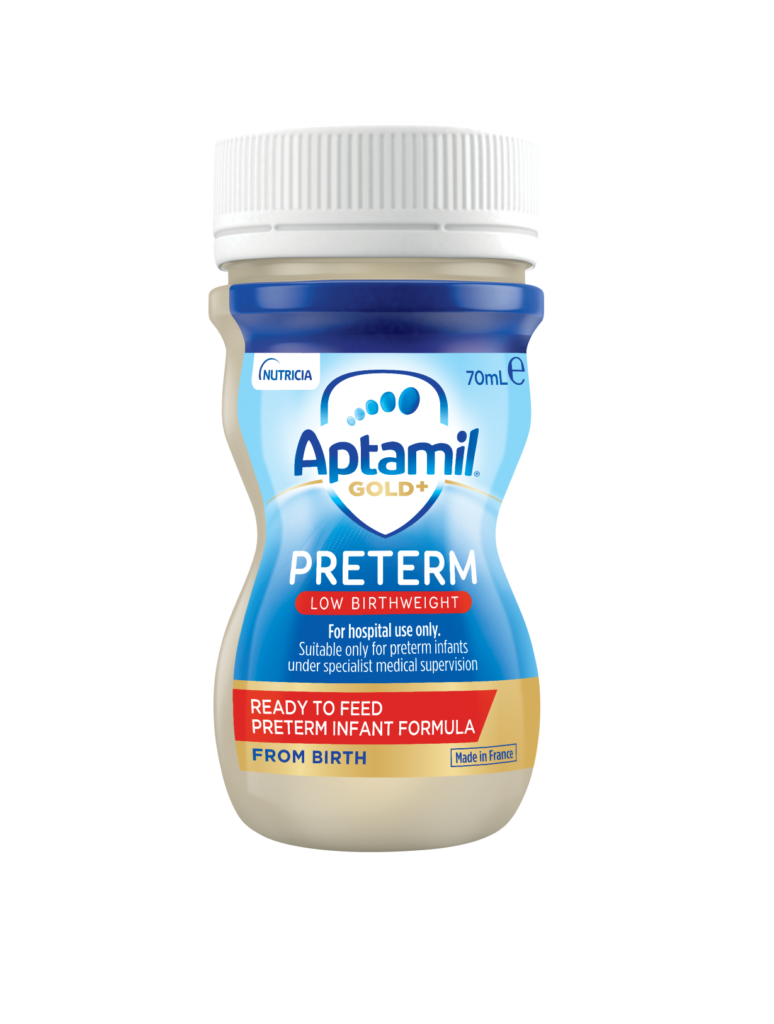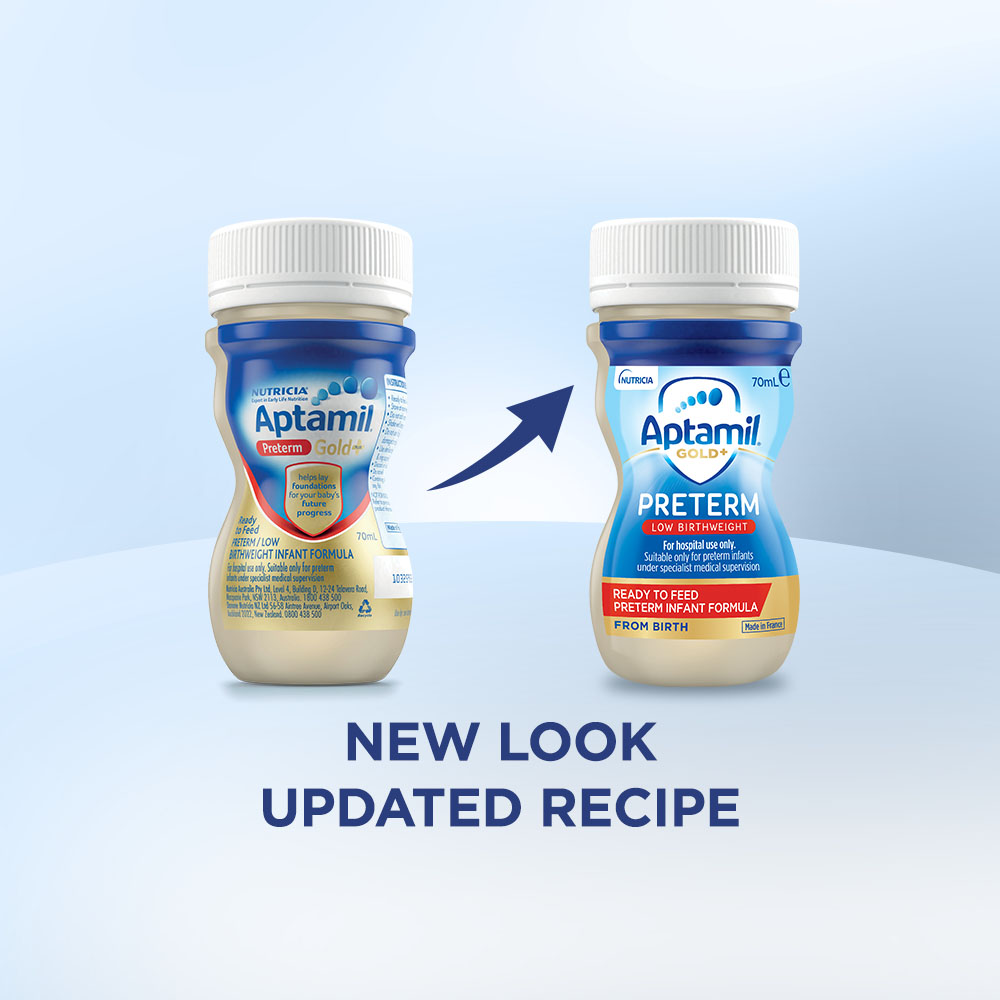

Product Information
A nutritionally complete, infant formula suitable for premature or low birth weight infants.
Note: Aptamil Gold+ Preterm Ready to Feed product label has a new look and the recipe has been updated. This is in line with our commitment at Nutricia to provide quality products and to continually ensure our products meet the needs of your patients.
Features
Aligned with ESPGHAN GuidelinesGrowth support
- Macronutrient levels in line with ESPGHAN guidelines.1
- Contains phospholipid bound DHA which is more efficiently absorbed than triglyceride bound DHA by preterm infants.2
- Contains medium chain triglycerides (MCT) which provide a quick source of energy to meet the growth needs of preterm infants.3
In preterm infants, Nutricia’s blend of prebiotic oligosaccharides (90% scGOS, 10% lcFOS), 0.8g per 100mL has been shown to:
- Significantly reduce the presence of clinically relevant pathogens in faecal flora which indicates that Nutricia’s prebiotics may protect against infections.4
- Increase levels of beneficial bacteria similar to those found in preterm breast-fed infants.5
Nutritional Information
| Average contents | per 100mL |
|---|---|
| NUTRITION INFORMATION | |
| Energy | 80 kcal |
| 335 kJ | |
| Protein | 2.7 g |
| Whey | 60 % |
| Casein | 40 % |
| Carbohydrate | 8.3 g |
| Sugars | 5.4 g |
| Lactose | 5.1 g |
| Fat, total | 3.9 g |
| Saturated | 1.6 g |
| Medium chain triglyceride | 0.34 g |
| Polyunsaturated | 0.6 mg |
| Linoleic acid (LA,ω-6) | 468 mg |
| Alpha linoleic acid (ALA,ω-3) | 68.7 mg |
| Arachidonic acid (AA,ω-6) | 20 mg |
| Docosahexaenoic acid (DHA,ω-3) | 20 mg |
| MINERALS | |
| Calcium | 101 mg |
| Phosphorus | 63 mg |
| Sodium | 70 mg |
| Potassium | 81 mg |
| Chloride | 86 mg |
| Magnesium | 7.4 mg |
| Iron | 1.6 mg |
| Zinc | 1.1 mg |
| Manganese | 6 μg |
| Copper | 80 μg |
| Iodine | 27 μg |
| Selenium | 4.5 μg |
| VITAMINS | |
| Vitamin A | 366 μg-RE |
| Vitamin D~3~ | 3.1 μg |
| Vitamin E | 4.6 mg-a-T.E. |
| Vitamin K | 6.7 μg |
| Thianin (B~1~) | 140 μg |
| Riboflavin(B~2~) | 200 μg |
| Vitamin B~6~ | 120 μg |
| Vitamin B~12~ | 0.2 μg |
| Niacin (B~3~) | 2.4 mg |
| Pantothenic acid (B~5~) | 0.84 mg |
| Vitamin C | 18 mg |
| Biotin | 3.6 μg |
| Folate | 35 μg |
| NUCLEOTIDES | |
| Total nucleotides | 3.4 mg |
| Cytidine-5′-monophosphate | 1.7 mg |
| Uridine-5′-monophosphate | 0.69 mg |
| Adenosine-5′-monophosphate | 0.43 mg |
| Inosine-5′-monophosphate | 0.37 mg |
| Guanosine-5′-monophosphate | 0.21 mg |
| MINOR NUTRITIONALS | |
| Choline | 26 mg |
| Taurine | 5.5 mg |
| Inositol | 24 mg |
| L-Carnitine | 2.1 mg |
| PREBIOTIC OLIGOSACCHARIDES | |
| Total prebiotics | 0.8 g |
| scGOS | 0.72 g |
| lcFOS | 0.08 g |
| Osmolality | 310 mOsmol/kg |
| Packaging size | 70 ml |
Ingredients
Water, milk solids, maltodextrin, vegetable oils (contains soy, antioxidants (ascorbyl palmitate)), galacto-oligosaccharides (contains milk) anhydrous milk fat, egg lipid, dried omega long chain polyunsaturated fatty acids (LCPUFAs) (contains fish, soy, antioxidants (mixed tocopherols, ascorbyl palmitate)), long chain polyfructose, acidity regulator (citric acid), emulsifier (mono- and diglycerides of fatty acids, soy lecithin), inositol, choline chloride, taurine, L-carnitine.
Mineral: Calcium, chloride, potassium, sodium, phosphorus, magnesium, iron, zinc, copper, iodine, manganese, selenium.
Vitamin: Vitamins (A, B1, B2, B3, B5, B6, C, D3, E, K1), folic acid, biotin.
Nucleotides: Cytidine-5′-monophosphate, uridine-5′-monophosphate, inosine-5′-monophosphate, adenosine-5′-monophosphate, guanosine-5′-monophosphate.
References
- Agostoni C et al. J Paediatr Gastro Nutr 2010; 50(1):85–91.
- Carnielli VP et al. Am J Clin Nutr 1998;67:97-103.
- Łoś-Rycharska et al. Gastroenterology Rev 2016; 11 (4): 226–231.
- Boehm G et al. Arch Dis Child Fetal Neonatal 2002; 86:F178–181.
- Knol J et al. Acta Paediatr 2005; 94(Suppl 449):31–33.
AA = Arachidonic Acid. DHA = Docosahexaenoic Acid. lcFOS = Long Chain Polyfructose from chicory inulin, formerly known as long chain Fructo-Oligosaccharides. LCPs= Long Chain Polyunsaturated fatty acids. scGOS = short chain Galacto-Oligosaccharides from milk.
